Beef stir-fry with ginger and scallion (姜葱牛肉) takes only fifteen minutes to prepare. Follow the ginger beef recipe below, which rivals any ginger and scallions beef stir-fry from Chinese restaurants.
The recipe is easy, but the flavor is addictive. Serve with a bowl of steamed rice, which will take you halfway to paradise.
You can get most of the seasonings right from your pantry. Buy a piece of good quality beef (tenderloin or chuck) and some scallions, and you are all set to cook up a storm in your kitchen.
Are you ready? Let’s get started.
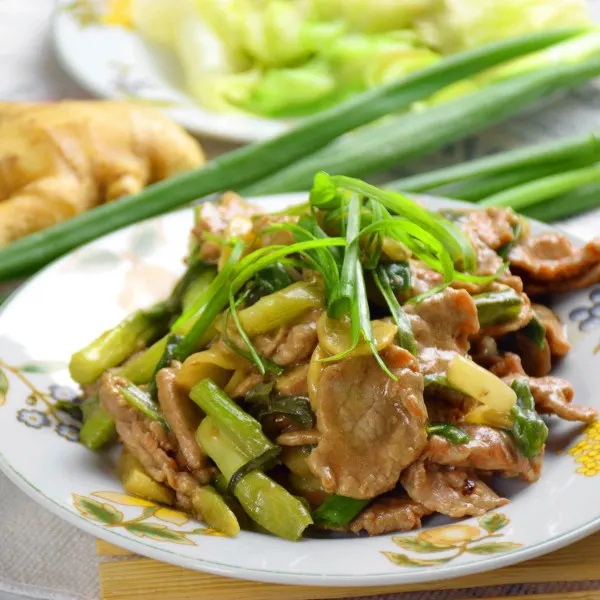
Note: This post may contain affiliate links. Please read my privacy policy for more info. I may receive commissions for purchases made through links in this post. As an Amazon Associate, I earn from qualifying purchases.
Tips for cooking the best ginger and scallion beef stir-fry.
Below is a comprehensive list of tips to produce the best ginger and scallion beef stir-fry. And trust me, if you follow all the tips listed here, you are well on the way to putting yourself in the elite league of stir-fry chefs :). Many of these points are useful for stir-frying in general. I strongly suggest you go through this section before attempting the recipe below.
1. Use the best cut of beef you can find
Choose a beef fillet or skirt steak that is marbled with some fat.
Why is it important? Because beef stir fry is a quick cooking process. You can use lower-grade beef for stew because the meat will be tender if you cook it for an hour or two on low heat. However, there is no such luxury for stir-frying as it is cooked in minutes.
2. The best way to cut the beef
Sirloin is best for stir-fries. But you can use a cheaper cut of beef like flank steak.
The meat should be cut into small pieces for beef stir-fry. This will allow it to cook within a very short time. Short cooking time will retain the beef’s juiciness, freshness, and flavor. Prolonged stir-frying will make the meat tough, dry, and weak in flavor.
Here are the steps:
- Cut the large block of beef into smaller chunks.
- Place it in a freezer bag.
- Eliminate as much air as possible in the bag and seal it to prevent freezer burn.
- Freeze it for about 30 minutes until the beef is partially frozen. (Note: it takes longer for the larger chunk of meat). Now the beef is firm enough to cut into thin slices.
- Cut the beef across the grain using the sharpest knife you have.
- Place it back in the freezer for a while until it gets firmer if you find that it is too soft.
- Wait until the meat slices thoroughly defrost before stir-frying.
The trick for a successful beef stir-fry is to slice the beef very thinly and cook it on very high heat for a brief time. Stir fry by using this method will ensure you get tender beef.
Cut the beef against the grain.
- Cut the beef into small chunks. Keep it in a freezer bag separately.
- Check your freezer’s temperature to ensure it is at zero degrees Fahrenheit. (-18 degrees Celsius). This is because freezer burn can only happen when temperatures fluctuate around 0° F.
- Squeeze out as much air as possible from the freezer bag. The objective is to expose the beef to a minimal amount of air.
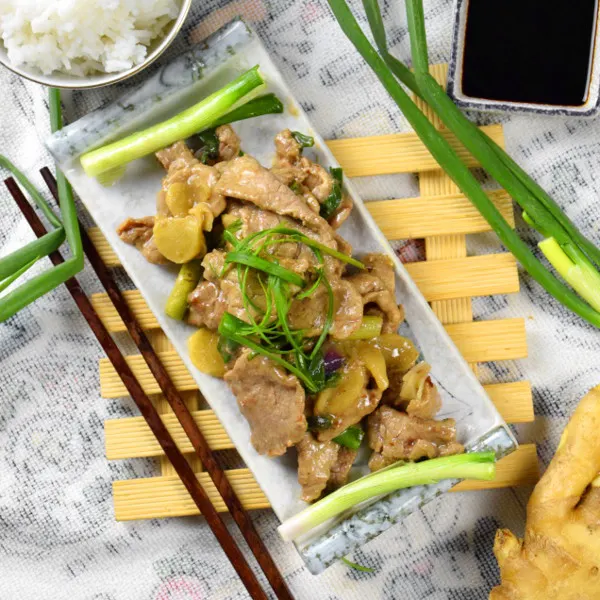
3. Avoid the beef from getting ‘freezer burn.’
You can purchase the meat in advance and place it in the freezer. However, you need to take care to prevent it from freezer burn.
Freezer burn is when pieces of ice form on your frozen foods. This happens because frozen food has been exposed to air.
When beef is frozen, water molecules within the beef form ice crystals. These water molecules prefer the most hospitable environment, i.e., the surface of the beef, which is the coldest place they can find. As a result, it will be dehydrated, tasteless, and have a distinct metallic flavor.
How to prevent freezer burn:
The way the meat is cut has a profound effect on its tenderness. All meat has grain, which is the direction of the fibers. Consequently, cutting the meat against the grain is vital, shortening muscle fibers and effectively tenderizing the meat. The meat will become tough and ropey if you cut along the grain.
What if you do not have a freezer bag? No problem. Keep the beef in a plastic container instead of a freezer bag. Cover the surface of the meat with cling film before attaching the cover. This will reduce the space between the food and the lid, thus minimizing freezer burn.
4. Marinate the beef to enhance the flavor
A good marinade helps to tenderize and improve the flavor of the beef.
The purpose of marinating the beef before stir-frying is to ensure the flavor penetrates into the inner part of the meat.
Steps to marinate the beef
- Slice 500 g of meat thinly against the grain.
- Combine the meat with 2 tablespoons of oyster sauce,1 tablespoon of light soy sauce, 1 teaspoon of sugar, 1 tablespoon of vegetable oil, and 2 teaspoons of cornflour.
- Marinate for at least 15 minutes, and you are ready to go.
5. How to prepare the ginger
Use young ginger for ginger and scallions beef stir-fry
The aroma, texture, and flavor of fresh ginger depend on its harvest. Fresh young ginger has a tangy flavor, warmth, and mellow sweetness, complementing the beef. That is why this combination is so popular in Asian cooking. On the contrary, mature ginger has more fibrous and with a spicy flavor.
Young ginger is the choice for beef stir-fry (in fact, for all stir-fries), as no one will enjoy chewing a fibrous piece of mature ginger. Young ginger has relatively thin, smooth, and papery skin with pinkish tips. Mature ginger has a darker color and looks wrinkled and shriveled.
How to peel and cut ginger:
- Use a vegetable peeler to scrape away the skin.
- Use the edge of a metal spoon to scrape away any other part of the skin between the little nubs. Using a spoon than a peeler in these areas is easier, as the peeler tends to peel away more flesh.
- Use a sharp paring knife to slice the ginger thinly for stir-frying.
6. How to prepare the scallion
Scallion (spring onions) is often used as an aromatic in beef stir-fry due to its unique Asian flavor. It is added to the wok in the final step, as it takes seconds to cook. It can also be eaten raw by cutting it into fine strips or very short sections.
Cut the scallion into pieces about 4-5 cm in length and throw into the wok to stir-fry on high heat for about 20 seconds. Turn down the heat and proceed to the final steps by adding the cornstarch slurry.
You can use additional scallion as the garnish by following this method
- Choose only fresh scallion, which is crisp and not wilted.
- Cut the scallion into about 4 to 5 cm long pieces.
- Use a parry knife to slice the scallion lengthwise into very fine strands.
- Place the sliced scallion into ice water for one minute.
- Remove the scallion strands (which are curled by now) and dry them on a kitchen towel.
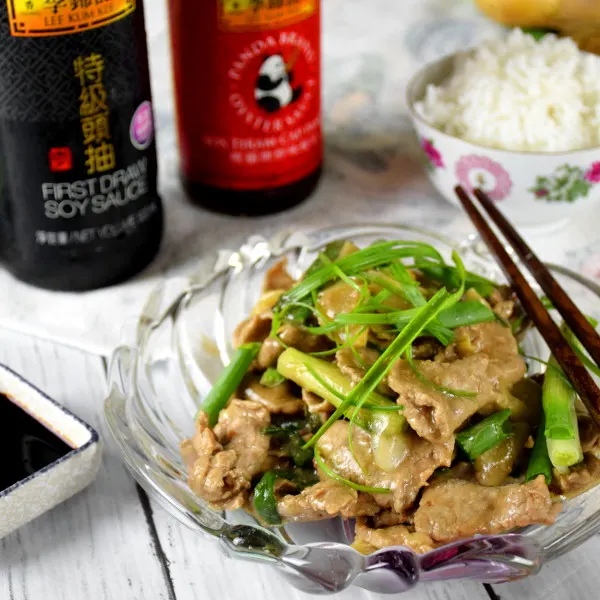
7. The stir-fry sauce for the beef stir-fry with ginger
Most street food vendors do not pre-constitute any sauces. Instead, they have all the seasonings (soy sauce, sesame oil, oyster sauce, salt, sugar, etc.) ready in individual containers beside the stove. They will pick them with a small spoon and place them in a ladle whenever they need.
They do that because of the volume and the speed required to serve the customers. But it has the apparent disadvantage of achieving consistency each time they cook.
Mixing the sauces in advance in a small bowl will eliminate the unintentional error of omitting some components or using the wrong quantities. This commonly happens as the required amounts of seasonings are relatively small.
The basic recipe for the stir-fry sauce: (for 1/2 kg of beef)
1 teaspoon of salt, 1 teaspoon of sugar, 1 teaspoon of light soy sauce, 1 tablespoon of oyster sauce, 1/4 teaspoon of ground white pepper, 1/2 teaspoon of cornflour, 3 tablespoons of water
These are ingredients that are traditionally used in Cantonese cooking. You can use this formula not only for beef stir-fry but applies for other Cantonese stir-fry. Feel free to adjust the amount of each component to your liking.
You can add a small amount of dark soy sauce, Shaoxing wine, and sesame oil to the sauce. Some people also like to sprinkle some sesame seeds on top before serving.
8. Stir-fry over the high heat (myth, lore, or science?)
You need a high temperature to create the signature aroma of stir-frying called wok-hei, or the “breath of wok.” High heat will lead to a chemical reaction (the Maillard reaction), which produces the complex flavor you are familiar with for the best Chinese takeout. However, this does not mean high heat is required for the cooking process. Here is how it should be done. Note the temperature required at different stages. Generally, we start with low heat, proceed to medium-high heat, and finish with high heat.
- Heat the oil over low heat. Flavor the oil with aromatic ingredients, such as ginger and scallion. (In this beef stir-fry recipe, I suggest adding ginger and only the white portion of the scallion. Keep the green section and add just about to finish cooking. )
- Push the ginger and scallion to the edge of the wok and set the heat to medium.
- Once the oil is piping hot, add the meat, quickly stir and toss.
- Use the wok shovel to arrange the beef in a single layer and let it sears for a while.
- Turn the heat up, and add the stir-fry sauce and the green section of the scallion. Quickly stir-fry for twenty seconds.
- Adjust the flame to medium heat. Add the cornstarch slurry to the food and stir-fry until the cornstarch is cooked and has thickened.
Note: You can also add the cornstarch slurry to the sauce.
9. Use a cast iron wok for stir-frying.
A wok is the most essential cooking equipment for Chinese or Asian cuisine. You can certainly cook Asian food in any pan. but the taste will not be the same. This is due to the material used to produce wok-hei and the unique shape of the wok against a flat-based pan.
Since a wok is bowl-shaped, it distributes heat uniformly to the food sitting in the center of the wok. For this reason, food can be cooked in a very short time. The wok can withstand extremely high temperatures required for stir-frying.
You can also easily toss the food due to its bowl-shaped. All these unique features of a wok make it an irreplaceable cooking utensil for proper stir-frying. If you do not process a wok, the best alternative is a large skillet.
10. Use a wok to stir-fry
Always buy a larger wok for stir-frying. A bigger wok allows the food pieces to move and flip freely. Stir-frying is messy with a small wok as you cannot stir and flip the food pieces freely as it tends to drop out from the edge.
Buy a good wok. Cast iron wok is the best, which is why it is used in most Asian restaurants. Wok-hei cannot be created in a stainless steel vessel, as it mainly arises from burning the patina of polymers and fats embedded on the surface of a well-used carbon steel wok or cast iron wok. That is why cast iron wok is superior to stainless steel wok.
11. Thicken the sauce with the cornstarch slurry
One of the unique features of Asian cooking is the ubiquitous presence of cornstarch slurry in stir-frying. It is added to the stir-fry ingredients in the last 20 seconds.
- Thicken the liquid produced from the stir-fry sauce and the juice of the ingredients. Otherwise, the soy sauce, oyster, wine, and the natural juices of the food will not be able to coat every morsel of food but settle at the bottom of the dish as a thin liquid.
- Create a smooth texture for the meat.
- Give a glossy sheen to the liquids as it thickens.
It is made with cornstarch and enough water to form a slurry that resembles thick cream. It is good to prepare in advance to keep things flowing at the time of stir-frying.
How to prepare cornstarch slurry:
- Add one part of cornstarch to one part of water. The amount of water should not be too high but just enough to form a thick slurry resembling thick cream.
- Ensure your wok is not too hot, as the slurry can immediately congeal once it hits the surface. This is especially important if you use cast iron wok with a higher heat capacity than steel. In this case, you may want to remove it from the heat and wait half a minute before you add the slurry.
- Be sure the cornstarch is cooked, as uncooked cornstarch will leave an undesirable starchy taste to the food.
- For simplicity, you can mix the cornstarch slurry with the seasoning to keep things flowing at stir-fry time.
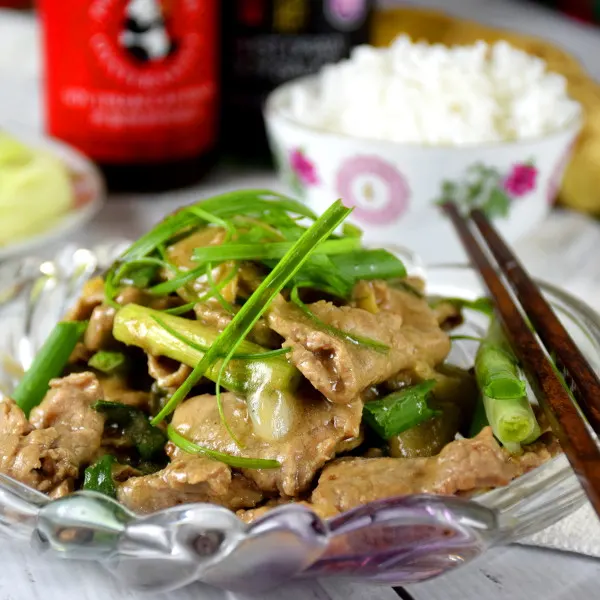
12 . Use a high-power output stove
Intense heat is one essential element unique to Asian cooking.
Use a high-output stove that can generate high heat, enabling every morsel of food to cook through in seconds.
So how can you achieve this at home with your relatively low-output stove?
Make your beef stir-fry in small batches. If you do not have a high-output stove that can generate roaring heat as in restaurant kitchens, stir-fry in small amounts. It is especially useful if you use a cast iron wok with high heat capacity. This way, the stove will generate sufficient heat (coupled with the high heat capacity of the cast iron wok) to cook a small amount of food quickly.
Additional note for the Ginger and Scallion Stir-fry Recipe
I wrote this ginger beef stir fry recipe two years ago. Cantonese people typically use this recipe for cooking beef at home. The main ingredients are only beef, ginger, and scallion.
However, I have seen some recipes also include snow peas, red bell peppers, and green beans. These are not the traditional ingredients for Cantonese stir-fry. It can be a delicious recipe since you can always switch things up and create new fusion recipes.
Some recipes also include chopped garlic or garlic powder which I find that it is unnecessary in this recipe.
I also read some recipes that include Hoisin sauce as one of the ingredients for the stir-fry sauce. Again, Hoisin sauce is not used in authentic Cantonese stir-fried beef.
In the Chinese restaurant setting, sometimes the beef is deep-fried instead of stir-fried. The chef deep-fried the beef slices briefly until they were cooked and then removed them from the oil with a slotted spoon. After that, the beef will then add back to the walk along with the ginger and scallion.
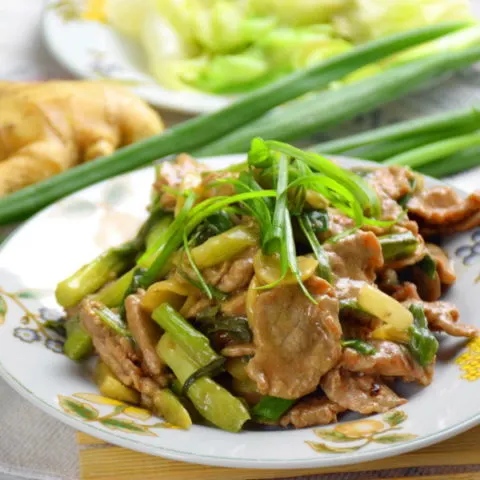
Ginger and scallion beef stir-fry
Beef stir-fry with ginger and scallion takes only fifteen minutes to prepare. Follow the receipt below which rivals any ginger and scallions beef stir-fry from any Chinese restaurant.
Ingredients
For marinating the beef (A)
- 250 g beef
- 1 tbsp light soy sauce
- 2 tsp vegetable oil
- 1 tsp corn starch
Other ingredients (B)
- 50 g young ginger
- 4 stalks scallion
- 2 tbsp vegetables oil, for stir frying
Seasonings (C)
- 1.5 tbsp oyster sauce
- 1 tsp light soy sauce
- 1 tsp sugar
- 1/4 tsp ground white pepper
- 1/2 tsp corn starch
- 4 tbsp water
- 1 tsp sesame oil, add right before finish cooking
- 1 tbsp Shaoxing wine, add right before finish cooking
Instructions
- Put the beef in the freezer until it's half frozen.
- Cut the beef into thin slices, against the grain.
- Marinate the beef with (A) for 15 minutes.
- Remove the skin of the ginger. Slice thinly.
- Cut the scallion lengthwise into sections of about 4 cm.
- Prepare the stir-fry sauce by combining all the ingredients in the 'stir fry sauce' section of the ingredient.
- Heat up some vegetable oil in a wok.
- Saute the slices of ginger over low heat until they turn fragrant. (about 1/2 min).
- Add the white section of the scallion. Stir fry for half a minute.
- Add the sliced beef. Turn up the heat. Stir and flip the beef quickly to avoid sticking on the surface of the wok.
- When the beef is just cooked, i.e. the color changed from pinkish to brown, add the seasoning (C),
- Add the scallion. Add the Shaoxing wine. Stir-fry over high heat for 15 seconds.
- Add the sesame oil . mix and serve.
Recommended Products
As an Amazon Associate and member of other affiliate programs, I earn from qualifying purchases.
Nutrition Information:
Yield: 2 Serving Size: 5 personAmount Per Serving: Calories: 558Total Fat: 39gSaturated Fat: 11gTrans Fat: 0gUnsaturated Fat: 24gCholesterol: 109mgSodium: 1187mgCarbohydrates: 14gFiber: 2gSugar: 4gProtein: 35g
This data was provided and calculated by Nutritionix on 5/22/2019.




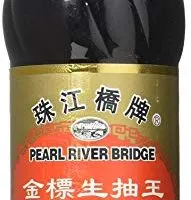
What Is A Stir-Fry? | CulinaryLore
Sunday 8th of June 2025
[…] How to stir-fry the authentic Asian Way – Beef Stir Fry […]
Annaliese
Wednesday 10th of October 2018
It was so easy and tasty. I have tried a few other versions of this recipe without much success by your advice was really useful for someone not overly familiar with cooking Chinese cuisine. I can’t wait to make it again. Thank you
KP Kwan
Thursday 11th of October 2018
Thank you so much for following this beef stir-fry recipe. So glad to know that you like it.
Connie
Wednesday 25th of July 2018
I made this last night. It was delicious! Because I need to make a lot, I used about 2 lbs. of beef. I scrounge my freezer for single odd sizes of steaks that won't work for a steak night at our house, a T-Bone, Strip, Rib-eye etc. I also added a bunch of broccoli florets and two green peppers slicee into chunks to fill out the meal. I stir fried the broccoli and peppers first then set aside. After that, I followed your recipe exactly increasing the amounts as needed, with the exception of adding a can of low salt beef broth and a little more cornstarch to the sauce since I needed more. Everyone loved it! Thank you for the website and tips! I love Asian foods and have so much more to learn.
KP Kwan
Wednesday 25th of July 2018
Hi Connie, So happy to know that you like the beef stir-fry, especially your improvisation on the recipe. I always believe that recipe only acts as a guideline. Once we know the technique, we can create many different dishes according to our liking. Cheers. KP Kwan
KP Kwan
Saturday 2nd of June 2018
Hi, this is KP Kwan. I am happy to see you in this comment area, as you have read through my recipe. I am glad to reply any questions and comments as soon as possible.
Kathleen Couter
Tuesday 24th of April 2018
Dear KL Kwan, Thank you ever so much for this great, detailed recipe I just can not wait to try out your recipes, which are so beautifully defined. Cheers Kathleen Couter.
KP Kwan
Tuesday 24th of April 2018
Hi Kathleen, You are welcome. Ther will be many more recipes to be posted.
KP Kwan